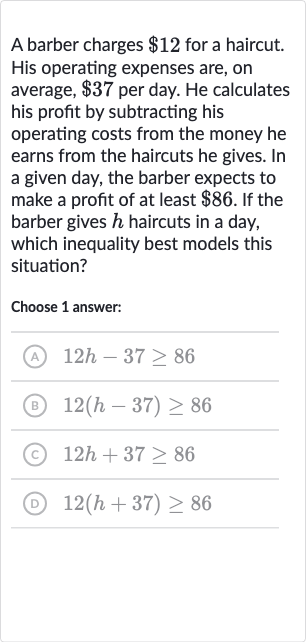AI tutor
Welcome to Bytelearn!
Let’s check out your problem:

A barber charges for a haircut. operating expenses are, on average, per day. He calculates his profit by subtracting his operating costs from the money he earns from the haircuts he gives. In a given day, the barber expects to make a profit of at least . If the barber gives haircuts in a day, which inequality best models this situation?Choose answer:(A) (B) (C) (D)
Full solution
Q. A barber charges for a haircut. operating expenses are, on average, per day. He calculates his profit by subtracting his operating costs from the money he earns from the haircuts he gives. In a given day, the barber expects to make a profit of at least . If the barber gives haircuts in a day, which inequality best models this situation?Choose answer:(A) (B) (C) (D)
- Define Variables and Situation: Define the variables and the situation.The barber charges per haircut and has operating expenses of per day. He wants to make at least profit in a day. Let represent the number of haircuts the barber gives in a day.
- Calculate Daily Earnings: Write an expression for the barber's daily earnings from haircuts. The barber earns for each haircut, so his earnings from haircuts would be dollars.
- Calculate Profit: Write an expression for the barber's profit.The barber's profit is his earnings minus his operating expenses. So, the profit can be expressed as .
- Set Profit Goal: Write an inequality to represent the barber's goal for profit. The barber wants to make at least profit, so the inequality should reflect that his profit should be greater than or equal to . Therefore, the inequality is .
- Match Inequality to Choices: Match the inequality to the given choices.The inequality we derived is , which matches choice .
More problems from Write two-variable inequalities: word problems
QuestionGet tutor help
QuestionGet tutor help
QuestionGet tutor help
QuestionGet tutor help
QuestionGet tutor help
QuestionGet tutor help
QuestionGet tutor help
QuestionGet tutor help
